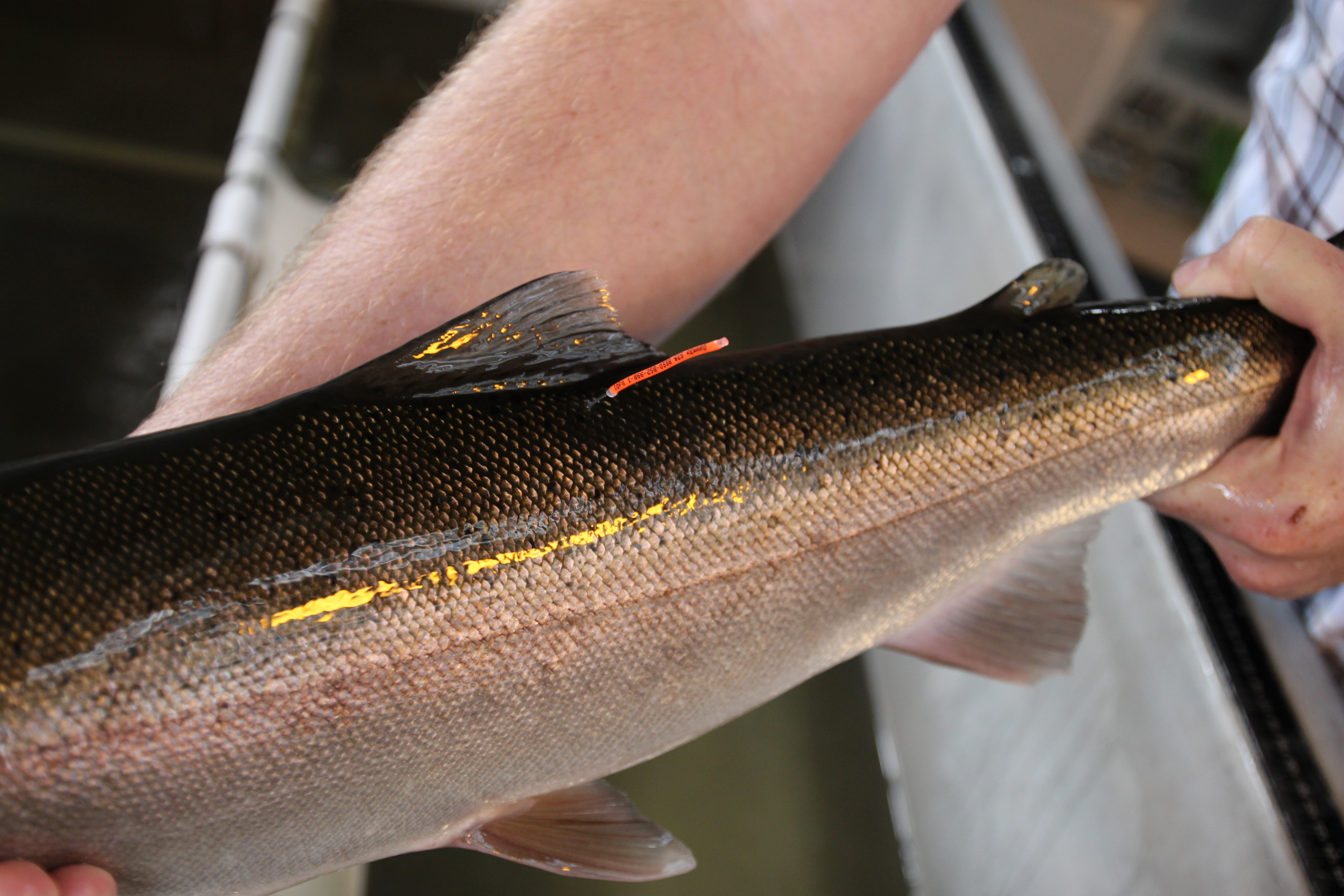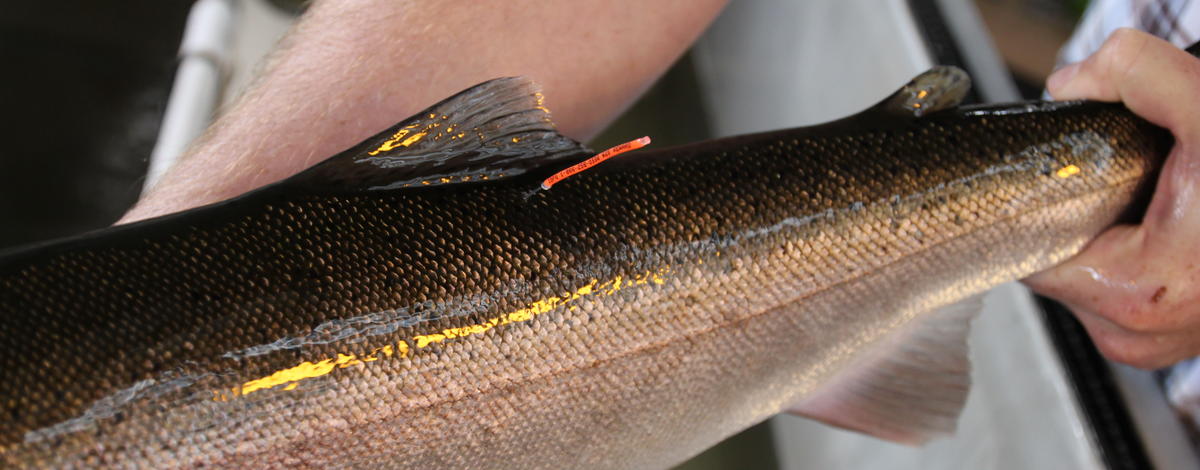A two-year study showed Idaho’s wild steelhead are caught by anglers less often than hatchery fish, and they survive at a very high rate after being caught and released. That’s good news for anglers because wild steelhead survival is critical to continuing fishing seasons and ensuring they are protected while anglers target hatchery fish.

The study was conducted by University of Idaho graduate student Will Lubenau under the guidance of UI professor Michael Quist and in cooperation with Idaho Fish and Game, the U.S. Geological Survey, along with anglers and outfitters, who were critical to the study’s success.
Tag, you’re fit
During the study, researchers tagged steelhead with visible orange tags and also inserted tiny electronic transponders into the fishes’ body cavities as they were coming over Lower Granite Dam on the Snake River downstream from Lewiston.

As they continued upstream, many fish were caught by anglers, who reported the visible tag back to the researchers. Then when the fish moved into spawning areas, biologists were able to detect them from the embedded electronic transponders and know how many survived their journey, and whether they had been caught by anglers.
Fish and Game managers had previously estimated that wild fish were caught about as often as hatchery fish, and figured about 5 percent of those wild fish caught and released by anglers were likely to die.
Lubenau’s research showed those estimates were high in both cases and that wild fish were caught about 22 percent less often than hatchery fish. Over the two years, about 33 percent of tagged wild steelhead were caught by anglers vs. about 55 percent of hatchery fish. More than 96 percent of wild fish survive catch-and-release fishing, even when they were caught twice.
Lubenau said the reason for that is fairly simple. The two types of steelhead tend to naturally segregate in the rivers, and anglers focus more attention and effort on hatchery steelhead.
“This shows the impact on wild fish is less than what we estimated,” Lubenau said. “And it was a consistent pattern across the whole fishery.”
Researchers also counted 31 wild fish that were caught twice during the same season, and the survival rates of those fish were nearly identical to fish that were only caught once. And Quist noted that steelhead mortality due to catch-and-release fishing is not just low, “these rates are very low compared to other fish species.”
It’s an important finding because fisheries managers strive to protect wild steelhead while also allowing anglers to catch, and harvest, hatchery steelhead.
One of the years of the study had an unusually small steelhead return, which prompted the Fish and Game Commission to temporarily suspend fall fishing, while the following year, the season ran continuously. Yet, the results were largely the same over the two years.
“I was surprised everything stayed so consistent,” Quist said. “Everything was right on the money.”
Study was a partnership with anglers
Quist and Lubenau pointed out that not only was this study important to help understand steelhead, it was important for fisheries managers. Had the results come out differently, it could have affected fishing seasons, not to mention the livelihoods of the outfitters and guides who rely on steelhead fishing.

Despite that, the angling community was wholly cooperative, and the research couldn’t have been done without their assistance.
“They were great to work with,” Lubenau said. “We now have better information than we had two years ago, and I think everyone is happy with how things turned out. It’s good news for anglers, and it’s good news for wild steelhead.”
More to the story than mortality
One of the side benefits of tagging steelhead is what’s observed beyond the scope of the research, and Lubenau’s study was no different. The unexpected things may have never been documented if the fish weren’t tagged and tracked.
One of the tagged steelhead was caught a little farther away than expected, specifically, in the Pacific Ocean during a trawl survey by the National Oceanic and Atmospheric Administration.
The steelhead had spawned in the Middle Fork of the Salmon River and returned to the ocean as a “kelt.” Unlike salmon, steelhead don’t necessarily die after spawning – although most Idaho steelhead do – but this one was particularly resilient and returned to the Pacific and was preparing to make another spawning run. Lubenau said another Idaho steelhead returned to the ocean, and within a couple months, it did an about face and headed right back up the Columbia River toward Idaho.
Another fish seemed to be either a slow learner, or maybe it just enjoyed a good scrap. It was caught and released three times, once near the mouth of the Clearwater River during late summer, then twice in the Upper Salmon River near Salmon during winter and spring.
While steelhead often stray, they typically wander into other rivers on their way upstream before eventually reaching the river where they were born.
But one fish decided to flip that script. It returned all the way to Idaho and was caught by an angler near Heller Bar on the Snake River upstream from Lewiston, then it reversed course and headed back down the Snake River and Columbia River before veering into the John Day River in Oregon, where it was detected by its electronic transponder.
“We encountered some pretty crazy things with these fish,” Lubenau said.
More university assistance to help fisheries
Lubenau’s research will benefit Idaho anglers by providing fisheries managers with a better understand of wild steelhead, and it’s not the only example of how graduate students are answering real-world questions through research to benefit Fish and Game’s fish management.
Similar research projects through the Idaho Cooperative Fish and Wildlife Research Unit, which includes Fish and Game, UI and USGS, are taking place, or about to take place, with bull trout in the North Idaho’s St. Joe River, with sturgeon in the Upper Snake River, and with perch and pikeminnow in Lake Cascade.

